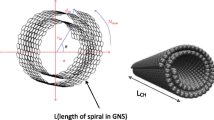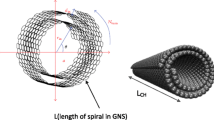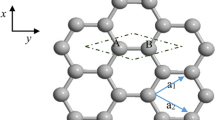Abstract
Graphene nanoribbon (GNR), a superior material with two-dimensional structure and monolayer honeycomb of carbon, is noteworthy and important in all fields’ mainly electronic, chemistry, biology, physics and nanotechnology. Recently, observing about sensors demonstrates that for better accuracy, faster response time and enlarged sensitivity, it needs to be improved. Nowadays, carbon-based equipments as an exclusive substance are remarkable in the sensing technology. High conductivity as unique properties caused that graphene can be used in biological applications. Gas sensor based on graphene can be supposed to have great sensitivity for gas molecules detection. In this study, graphene-based carbon dioxide sensor analytically is modeled. In addition, new methods of gas sensor model based on the gradient of GNR conductance are provided. Also, a field effect transistor-based structure as a modeling platform is suggested. Ultimately, optimum model is evaluated by comparison study between analytical model and experimental performance.



Similar content being viewed by others
References
Wei X-L et al (2012) Enhanced gas sensor based on nitrogen-vacancy graphene nanoribbons. Phys Lett A 376(4):559–562
Arshak K, Moore E, Lyons GM, Harris J, Clifford S (2004) A review of gas sensors employed in electronic nose applications. Sens Rev 24(2):181–198
Zhang Y-H et al. (2009) Improving gas sensing properties of graphene by introducing dopants and defects: a first-principles study. Nanotechnology 20(18):185504. doi:10.1088/0957-4484/20/18/185504
Kochmann S, Hirsch T, Wolfbeis OS (2012) Graphenes in chemical sensors and biosensors. TrAC Trends Anal Chem 39:87–113. http://dx.doi.org/10.1016/j.trac.2012.06.004
Massera E et al (2012) Gas sensors based on graphene comparison of two different fabrication approaches. Chim Oggi-Chem Today 30(2):29–31
Huang B et al (2008) Adsorption of gas molecules on graphene nanoribbons and its implication for nanoscale molecule sensor. J Phys Chem C 112(35):13442–13446
Bradley D (2012) Graphene gas sensor CARBON. Materials Today, vol 15, no 6, June 2012, Page 233
Schedin F et al (2007) Detection of individual gas molecules adsorbed on graphene. Nat Mater 6(9):652–655
Kochmann S, Hirsch T, Wolfbeis OS (2012) Graphenes in chemical sensors and biosensors. Trac-Trends Anal Chem 39:87–113
Singh V et al (2011) Graphene based materials: past, present and future. Prog Mater Sci 56(8):1178–1271
Guy OJ Sensor for detecting biological molecule comprises graphene structure; two electric contacts arranged in contact with graphene structure; and linker attached to graphene structure, where graphene has binding affinity for biological molecule, Uws Ventures Ltd
Duan X, Huang Y, Bai J, Graphene nanomesh for forming transistor, sensor, and graphene structure, comprises sheet of graphene having periodically arranged apertures, where the apertures have a substantially uniform periodicity and substantially uniform neck width, University of California
Zhou M et al (2011) Adsorption of gas molecules on transition metal embedded graphene: a search for high-performance graphene-based catalysts and gas sensors. Nanotechnology 22(38):385502. doi:10.1088/0957-4484/22/38/385502
Leenaerts O, Partoens B, Peeters FM (2008) Adsorption of H(2)O, NH(3), CO, NO(2), and NO on graphene: a first-principles study. Phys Rev B 77:125416
Dai J, Yuan J, Giannozzi P (2009) Gas adsorption on graphene doped with B, N, Al, and S: A theoretical study. Appl Phys Lett 95:232105
schwierz F (2010) Graphene transistors. Nat Nanotechnol. doi:10.1038/NNANO.2010.89
Wouter Olthuis EF, Erik Krommenhoek, Albert van den Berg (2007) Sensing with FETs—once, now and future. UTpublications
Ahmadi MT et al (2008) Modelling of the current–voltage characteristics of a carbon nano tube field effect transistor. In: Icse: 2008 Ieee international conference on semiconductor electronics, proceedings p 576–580
Ahmadi MT et al (2008) Carrier velocity in carbon nano tube field effect transistor. In: Icse: 2008 Ieee International conference on semiconductor electronics, proceedings p 519–523
Xia JL et al (2009) Measurement of the quantum capacitance of graphene. Nat Nanotechnol 4(8):505–509
Ahmadi MT et al (2010) Graphene nanoribbon conductance model in parabolic band structure. J Nanomater 2010(2010):753738
Ahmadi MT, Ismail R (2010) Graphene nanoribbon fermi energy model in parabolic band structure. In: IEEE, Uksim-Amss first international conference on intelligent systems, modelling and simulation, pp 401–405
Yoon HJ et al (2011) Carbon dioxide gas sensor using a graphene sheet. Sens Actuators B Chem 157(1):310–313
Karimi FAH, Ahmadi MT, Rahmani M, Akbari E, Kiani MJ, Khalid M (2012) Analytical modeling of graphene-based DNA sensor. Sci Adv Mater 4(11):1142–1147
Acknowledgments
Authors would like to acknowledge “This work is financed by Malaysia–Japan International Institute of Technology (MJIIT) (Universiti Teknologi Malaysia Vote: 4J010, Project Titled: Intelligent Fault Detection and Diagnosing for Process Plant.” Also thanks to the Research Management Center (RMC) of University Teknologi Malaysia (UTM) for providing excellent research environment in which to complete this work.
Author information
Authors and Affiliations
Corresponding author
Rights and permissions
About this article
Cite this article
Akbari, E., Yousof, R., Ahmadi, M.T. et al. The effect of concentration on gas sensor model based on graphene nanoribbon. Neural Comput & Applic 24, 143–146 (2014). https://doi.org/10.1007/s00521-013-1463-2
Received:
Accepted:
Published:
Issue Date:
DOI: https://doi.org/10.1007/s00521-013-1463-2




